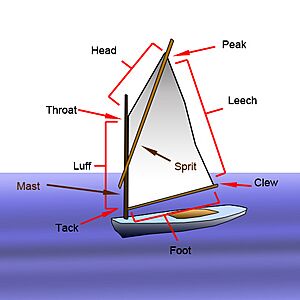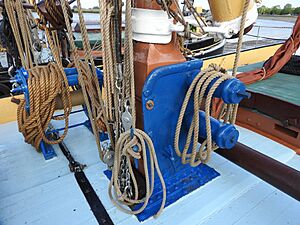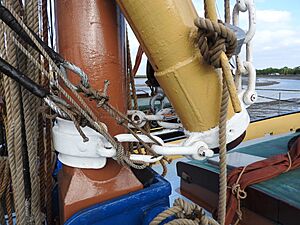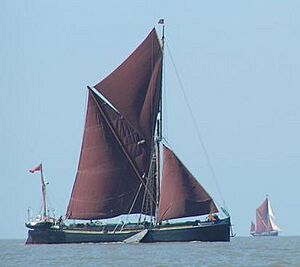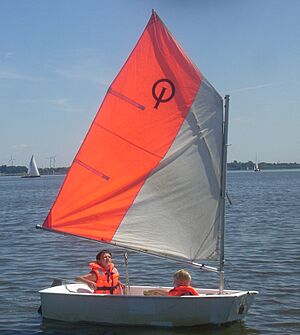Spritsail facts for kids
A spritsail is a special type of sail used on boats. It has four sides and is set up so it runs from the front to the back of the boat (this is called a fore-and-aft sail). What makes it unique is a long, diagonal pole called a sprit. This sprit helps hold up the top outer corner of the sail.
The spritsail is attached to the mast (the tall pole in the middle of the boat) and the sprit. The bottom edge of the sail can either be attached to another pole called a boom, or it can hang freely, controlled by ropes called sheets. Every spritsail has four important corners: the throat, peak, clew, and tack. Sometimes, the word "spritsail" can also describe the whole way a boat is set up with this type of sail.

Did you know spritsails were the very first type of fore-and-aft sails used in Europe? They first appeared in Greco-Roman times, around 200 years before Christ!
Contents
How a Spritsail Works
The front edge of the spritsail is tied to the mast. But unlike some other sails, the top outer edge (called the leech) is held up by the diagonal pole, the sprit. One end of the sprit is attached to the mast, and the other end goes up to the very top corner of the sail, called the peak.
To keep the sprit steady and control the sail, ropes called vangs are used. These vangs connect the peak of the sail down to the deck of the boat. Many people believe the spritsail was the ancestor of another common sail type, the gaff rig, which became popular in Holland in the 1500s. The bottom of the spritsail can be attached to a boom, or it can be "loose-footed," meaning it hangs freely and is only controlled by ropes.
Spritsails on Barges
The spritsail was very well known for its use on Thames sailing barges. These barges used two poles of similar size to create the shape of the sail. On a barge, the mast stands straight up in a special box called a mast case or tabernacle. The sprit hangs from the top of the mast at an angle, usually about 30 degrees from straight up. The sprit is usually on the right side (starboard) of the mast.
The bottom end of the sprit is held to the mast by a fitting called the muzzle. This muzzle allows the sprit to swing from side to side. This movement helps the barge sail in different directions, like when it's reaching or running with the wind. However, because the sprit is a heavy pole and can swing far out, boat designers had to be careful to make sure the barge stayed balanced. The very top corner of the sail is always attached to the end of the sprit, and two sets of vangs keep it steady.
Usually, spritsails on barges did not use a boom at the bottom. Booms are often used on other boats to keep the sail in a good shape for catching the wind. But on barges, having a loose-footed (boomless) sail had many benefits. For example, it made it easier to load and unload cargo because the sail didn't get in the way of the cargo hatch.
One big advantage of the spritsail rig on barges was safety in open water. Barges didn't carry heavy ballast (weight at the bottom to keep them stable). If too much wind pushed them over, they could lean too much. With a boom, if the boat leaned, the end of the boom could drag in the water, making it hard to steer and possibly causing the boat to tip over. But with a loose-footed spritsail, the ropes could just be let go, and the boat would quickly regain control. Also, since there was no boom sticking out, barges could pass through narrow spaces between other boats.
Barge crews could control the sail without leaving the deck by using a method called brailing up. Instead of lowering the entire sail, it was gathered up against the mast and the sprit using special ropes called brails. This was a very effective way to store the sail and allowed for fine control over how much wind the sail caught. In narrow waterways or when sailing past tall buildings, the main spritsail and mizzen sail would be brailed up, and the boat would sail only with its topsail and foresail.
One challenge with the sprit rig is that the sail is stored high up and is hard to reach from the deck. This also means it's not easy to cover the sail to protect it from bad weather. However, the crews of working boats like barges often didn't worry about such things. They traditionally treated their sails with special substances to protect them.
To solve the problem of the sail being hard to reach, Thames barges had a clever solution: the mast was set in a tabernacle, and a windlass (a type of winch) on the front deck could be used to lower the entire mast, sprit, sails, and all the ropes! This allowed the crew to sail under low bridges, like those at Aylesford or Rochester, without losing control of the boat. After passing the bridge, the skipper and another person (called a huffler) would use the windlass to raise the mast again.
Spritsails on Small Boats
Spritsails are also common today on small sailboats called Optimist (dinghy)s. These Optimists use a spritsail with a boom. On these boats, the sprit is pulled tight by a simple rope system called a snotter. This setup is much simpler than on barges, and the sprit is attached higher up on the mast.
Triangular Spritsails
There's also a type of spritsail that uses a triangular sail. The front edge of this sail is tied to the mast, and a single pole, called a sprit-boom, attaches to the bottom outer corner of the sail. The front end of this sprit-boom is pulled tight to the mast using a snotter rope. This design was an early version of what's now known as the wishbone rig, which became popular with windsurfers.
Spritsails on Local Boats
Spritsails are also commonly used on traditional wooden boats along the west coast of Norway, especially on a type of boat called the Oselvar. These boats used to have square sails until the late 1800s, but then many switched to the spritsail. You can also see spritsails on boats in places like Bangladesh.
Spritsails on Square-Rigged Ships
It can be a bit confusing, but the word "spritsail" also refers to a completely different type of sail used on some Square-rigged ships. These were typically older ships built before the mid-1800s. This "spritsail" is not related to the fore-and-aft spritsail we've been talking about.
On square-rigged ships, the spritsail was a square-shaped sail set underneath the bowsprit (a large pole sticking out from the front of the ship). Sometimes, an even smaller "spritsail topsail" was set above it, but this sail stopped being used early in the 1700s. This square spritsail, along with its yard (the pole it hung from), also helped support other poles at the front of the ship.
See also
- Crab claw sail
- Oselvar


